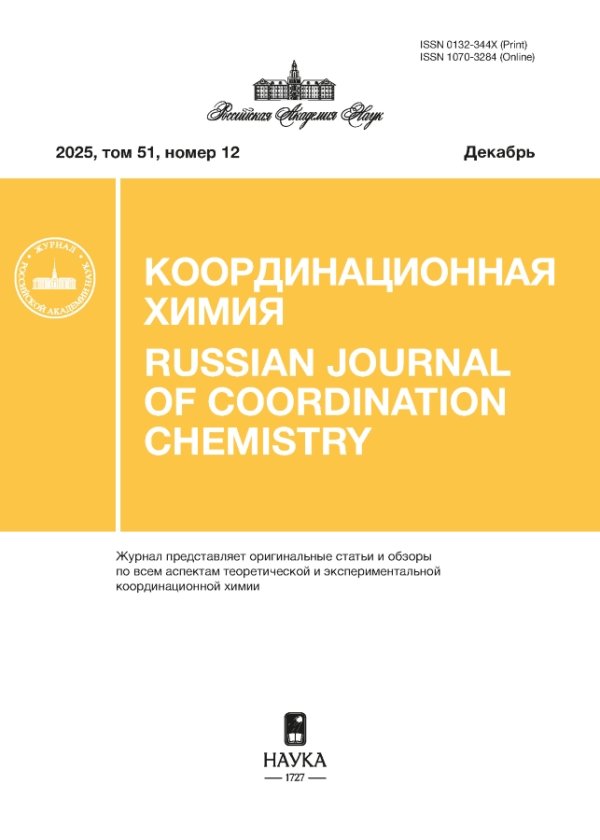Vol 49, No 5 (2023)
Articles
The First Perylene Complexes of Neodymium and Dysprosium
Abstract
Neodymium and dysprosium perylene complexes LnI(Per)(DME)2⋅Per (Ln = Nd, Dy) were obtained for the first time by the reaction of the Ln diiodides with perylene in dimethoxyethane. The structure of dysprosium complex was established by X-ray diffraction (CCDC no. 2184200). Experimental–theoretical electron density analysis was performed to specify the type of coordination between the dysprosium cation and perylene in DyI(Per)(DME)2⋅Per. Despite the identical composition, the Nd and Dy complexes have different structures, which is reflected in their luminescence properties.
 259-268
259-268


Synthesis, Structure, and Electron Density Distribution in Crystals of K2(L-Trp)2(H2O) (HTrp = Tryptophane)
Abstract
The first salt of alkaline metal and L-tryptophane, K2(L-Trp)2(H2O) (I), is synthesized by the reaction of L-tryptophane (HTrp) with potassium hydroxide in an aqueous-alcohol solution. Compound I is characterized by IR and 1H NMR spectroscopy and X-ray diffraction (XRD) (CIF file CCDC no. 2184367). Compound I is found to have a layered structure due to the presence of the bridging water molecule and chelate-bridging anions. The quantum chemical calculations of the crystal structure (PBE, plane-wave basis set, 800 eV) is used to evaluate the strength of interactions of the potassium ion with the L-tryptophanate anion (depending on the coordination type) and the influence of the anion conformation on the strength of coordination, hydrophobic, and hydrophilic interactions.
 269-277
269-277


Heteroleptic Metal-Organic Frameworks of Lanthanides (Lа, Ce, and Ho) Based on Ligands of the Anilate Type and Dicarboxylic Acids
Abstract
New heteroleptic metal-organic frameworks of lanthanides, units of which contain anionic organic ligands of two types, are prepared by the solvothermal synthesis in N,N-dimethylformamide (DMF). The cross-linked coordination polymer [Ho2(CA)2(Bdc)·4DMF] (I) and two scaffold derivatives [La2(pQ)2(Bpdc)·4DMF] (II) and [Ce2(CA)(Bdc)2·4DMF]·2DMF (III·2DMF), where CA is chloranilic acid dianion, pQ is 2,5-dihydroxy-3,6-di-tert-butyl-para-benzoquinone dianion, Bdc is terephthalic acid dianion, and Bpdc is 4,4'-biphenyldicarboxylic acid dianion, are synthesized. The structures of compounds I, II, and III·2DMF are studied by X-ray diffraction (XRD) (CIF file CCDC nos. 2212230, 2212231, and 2212232, respectively).
 278-289
278-289


Structure and Thermal Characteristics of Bis(triethylammonium)-tetrakis(3,5-dinitro-2-pyridonato)cobalt(II)
Abstract
The ionic compound [Co(OC5H2N(NO2)2)4]((C2H5)3NH)2 (I) was synthesized by the reaction of CoCl2·6H2O with 2-hydroxy-3,5-dinitropyridine in acetonitrile in the presence of triethylamine as a deprotonating agent. The structure of compound I was studied by X-ray diffraction (CCDC no. 2196071) and thermodynamic characteristics of I were determined.
 290-297
290-297


Halide Complexes [(2-Br-5-MePy)2ZnX2] (X = Cl, Br): Structure and Noncovalent Interactions in the Crystal Structure
Abstract
The heteroligand complexes [(2-Br-5-MePy)2ZnX2] (X = Cl (I), Br (II)) were prepared by the reaction of zinc(II) chloride or bromide with 2-bromo-5-methylpyridine and studied by X-ray diffraction (CCDC nos. 2204966 (I) and 2204967 (II)). The crystals of I and II contain Cl···Br and Br···Br halogen bonds, which connect the [MX2L2] moieties into supramolecular chains. The energies of these noncovalent interactions were estimated using quantum chemical calculations.
 298-302
298-302


Monovalent Thulium. Synthesis and Properties of TmI
Abstract
The reaction of thulium shavings with iodine at 680°C gave a poorly separable product mixture A, consisting of thulium metal (65%), TmI2 (14%), and TmI (21%). Monovalent thulium iodide could not be isolated in a pure state, but its presence among the products was confirmed, apart from magnetic measurements, by reactions with naphthalene and perylene, which proceed under mild conditions. The reaction of TmI with naphthalene, which takes place at –40°C, affords the trivalent thulium complex with naphthalene dianion, [TmI(C10H8)(DME)3]. The multistep reaction with perylene starts with the formation of the divalent thulium radical anion complex, [(TmI)+(C20H12)–•(DME)3], and ends in the formation of trivalent thulium complex, [(TmI)2+(C20H12)2–(DME)3]. The presence of a radical anion intermediate in the reaction mixture in an early stage was confirmed by ESR spectroscopy.
 303-307
303-307


A Surprising Example of Crystal Structure Retention for 3,5-Di-(tert-butyl)-2-hydroxyazobenzene Ligand during the Formation of Ni(II) and Pd(II) Complexes
Abstract
The structures of 3,5-di-(tert-butyl)-2-hydroxyazobenzene (L) in the free state and in complexes with Ni2+ (I) and Pd2+ (II) cations are studied by X-ray diffraction (XRD). The same space group R3¯с with close unit cell parameters, the same crystal structure motif, and unusual conformations of the cupola-shaped coordination polyhedra of complexes I and II are revealed by XRD for ligand L. In complexes I and II based on this compound as the ligand, the coordinating atoms form trans-planar coordination nodes.
 308-314
308-314


Synthesis and Structure of Tetraphenylstibonium Organosulfonates Ph4SbOSO2R, R = C10H15O, C10H4(OH-1)(NO2)2-2,4, C10H7-1, C6H4(COOH-2)
Abstract
The reaction of equimolar amounts of pentaphenylantimony with camphor-10-sulfonic, 2,4-dinitro-1-naphthol-7-sulfonic (flavianic), 1-naphthalenesulfonic, and 2-sulfobenzoic acids in benzene resulted in the synthesis of tetraphenylstibonium organosulfonates Ph4SbOSO2C10H15O∙H2O (I), Ph4SbOSO2C10H4(OH-1)(NO2)2-2,4∙PhH (II), Ph4SbOSO2(C10H7-1)∙H2O (III), and Ph4SbOSO2C6H4(COOH-2) (IV). According to X-ray diffraction data (CCDC no. 2119791 (I), 2121381 (II), 2116582 (III), and 2123516 (IV), the crystal of I contains trigonal-bipyramidal sulfonate molecules (the axial Sb−C and Sb−O bond lengths are 2.130(3) and 2.565(2) Å, respectively) and hydration water molecules, which form a centrosymmetric eight-membered ring (the S=O∙∙∙H−O−H∙∙∙O=S distances are 2.06 and 2.21 Å). In the molecules of II, the metal atom geometry is a distorted trigonal bipyramid (the axial Sb−C and Sb−O bonds are 2.133(2) and 2.643(3) Å, respectively). The Sb−O distance (2.842(3) Å) is longer in III than in I or II; the hydration water molecules form centrosymmetric twelve-membered rings with the anions (the S=O∙∙∙H−O−H∙∙∙O=S distances are 2.02 and 2.05 Å). Meanwhile, the crystal of compound IV consists of tetrahedral tetraphenylstibonium cations and (2-carboxy)benzenesulfonate anions with the intramolecular O−H∙∙∙O=S hydrogen bond (1.75 Å).
 315-320
315-320












